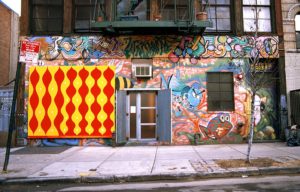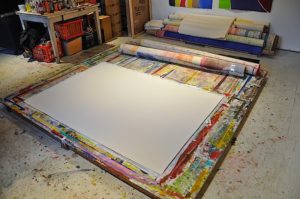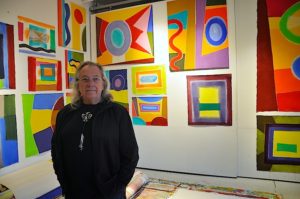Remember those late-night pizza parties at Emilio’s in the Village? The East Village gallery scene? Concerts at the Academy of Music? New Yorkers love to talk about the good/bad old days and bemoan the fate of their neighborhoods, their unique residents and local businesses. Lovers of SoHo’s late art scene complain it has morphed into a shopping mall – such an un-Manhattan construct! Rising rents and the demolition of vintage brick-and-mortar in favor of sterile steel towers and concrete caverns pave the way for the displacement of unique retailers and restaurants by an alien invasion of national chains, yes, here. From SoHo to Chelsea, The Lower East Side to Long Island City, the skyline sprouts shining towers in all directions.
But there is always somewhere, isn’t there? Up ‘til today, somewhat true, but the boomtown mentality in place assures that as quickly as artists turn to places like Bushwick, Ridgewood, and Red Hook, the districts fall like dominos in the path of the re-development juggernaut. Williamsburg was one of the first neighborhoods across the river to experience this dramatic shift in population and property, and there are lessons to be heeded from those who were there from the beginning.
The best way I can describe Richard Timperio’s role in the New York art community is “fearless leader,” and I am sure many artists and art lovers will agree. One of the first artists to settle in Williamsburg, he saw purpose and potential in making space for the neighborhood’s growing creative community to exhibit and exchange ideas. Thus Sideshow Gallery – the name itself a play on the notion of Manhattan as the “Big Top” – was born. Sideshow Gallery remains today a mainstay of the district and a mecca for serious, talented and accomplished artists, famous or not. Timperio’s mission, in his own words, is to provide a forum for “ all art that attains a high level of quality embodies integrity, regardless of style or approach. Where the art itself is the only thing that matters.” Even with the financially hyper-charged symbiosis of today’s art and real estate markets swirling outside his doors, Timperio’s integrity and commitment do not waver. Sideshow invariably impresses its audience with masterful and thought-provoking solo shows, as well as an over-the-top, must-see annual group “extravaganza” that has grown to include around 600 artists, the installation of which is a monumental work of art in itself.
Timperio’s position gives him a unique perspective on the intense re-development of Williamsburg’s real estate and the impact it has on artists, galleries and people in general, including himself and Sideshow, which seems set to stay in place for the moment, as he explains, “I’m lucky. I can’t really say that this affects my work because I‘m not threatened to move since I own, but I will eventually be forced to move because of the rising taxes and having to comply with all the new codes.”
However, he sees the negative impact on other artists. “It is becoming so expensive to rent, that in many cases artists are forced to move out of the city. Artists need affordable spaces to work, and the only spaces available are in industrial buildings which have been carved up into small expensive work spaces that rent for $800-$1000 for 250 square feet. Artists moved to Brooklyn because it was close to Manhattan and you could get a huge live/work space for almost nothing, this gave artists the freedom to explore their creativity. This basically doesn’t exist any more.”
What affects artists, affects art, and Timperio has witnessed a change. “The work seems to be smaller,” he observes. “Given the confined spaces there is an intense interest in sales and salability. Everything is driven by money, and that has become the defining factor with current art. It doesn’t even have the pretense of having a higher purpose.”
How does that impact the entire community? As for the neighborhood in general, Richard notes, “The population has completely changed. The area once populated with artists is now being taken over by people with deep pockets who have other interests and needs. The neighborhood has become sanitized and void of the character it once had. Small businesses are forced out because they can’t handle the ridiculous rents. Once their leases are up the rent can triple, making it impossible to stay.”
Don’t the people living and working in Williamsburg still have a say in its transformation, similar to how a user’s feedback might improve a popular real estate search platform? “The neighborhood community board once had a significant impact on development,” Richard recalled. “Now, their insights and recommendations seem to be ignored. It’s as if we’re in Dubai, an oasis where wealth floods in without end. Once the original artists and local residents are priced out and depart, the essence that made this community so captivating vanishes. The neighborhood is on the brink of becoming a hollow shell, akin to a high-end shopping center, and the real treasures—creative vibrancy and community spirit—are fading.”
“I don’t have much hope for our current situation, maybe the bubble will burst and some of this crazy development will at least slow down,” he added, musing on the future. “The possibility of duplicating the past is gone. Young artists have to cover two rents, home and studio, each a sizeable amount of money, forcing them to spend most of their time working and having very little time to create. Eventually, to exist they have to move further and further away. In the late 90’s Williamsburg and surrounding areas had the largest concentration of artists in the world. The population of artists has dwindled, we have been replaced by luxury apartment buildings.”
Timperio’s tenure in the neighborhood began at a time he describes as a low point. “When I moved to Williamsburg in 79 it was a Puerto Rican community with a handful of white artists, many empty buildings… and don’t forget the gangs. Prior to that, there was a community of black artists and jazz musicians living around the bridge on Broadway. When we moved in only a few of them were still around. It was very isolated, nothing here except for the bodegas and a supermarket that left a lot to be desired. We used to drive the kids miles away to take a walk.”
What was the turning point? “By the late 90’s it had started to change. There was a wave of new people in 96, but nothing really to talk about until 99, when an article in the UTNE reader 1 listed the 3 hippest neighborhoods in the US, one in San Francisco, one in New Orleans and Williamsburg. The article really accelerated the change, the population of Williamsburg exploded!”
Was the role of the media that of a friend or foe of creative living? “Let’s just say it helped to set up what was about to happen,” Timperio said. “More people were turned on to this creative new place. Europe had already been aware of Williamsburg. The New York Times was constantly reviewing the galleries here. Roberta Smith wrote a large article 2 about them in the Sunday Times. Everyone thought that article was about the art. It really was about real estate.
There were just four galleries and a few artists who turned their studios into galleries for a couple of months just to be in the article. Let’s just say once the building began, all of the attention from the Times and other sources dried up. Media can have a significant effect on the direction of neighborhood development. An article can be a kind of advertising to turn a forgotten neighborhood into someplace very desirable.”
At first it was a welcome respite: “The best part was when everyone realized things were about to change. The neighborhood had been forgotten for so long. It was still a village and everyone knew everyone, there was excitement in the air, this was just before the hyper-gentrification storm and the new construction had not started. It was around 97. It was becoming less dangerous and more livable. You could take a walk. But, we didn’t think the change would be so drastic…I didn’t think they were going to tear it all down.”
On the current situation, he continued, “The number of new buildings being built seems to be endless. Hyper-gentrification has taken over and people are being packed in to the max. And the infrastructure is completely unable to handle the new growth. Expansion seems to be exploding without any thought or planning, a free-for-all for developers.
“It just seems ridiculous — the lack of planning, all for profit. As soon as the zoning changed, it became a free-for-all. There was no concern for the tax on all of the services. They can’t put any more cars on the L train. It’s completely maxed out. There are just too many people. In the morning, you have to watch trains go by because they’re packed. They’re now talking about a tram to take care of the rising population. Ferries can’t move enough people, the traffic is horrible. I know two people who’ve been hit by cars, watched two women get hit. There are too many people and there are more coming. We need to think more clearly about what we’re creating and how it affects everyone.”
Of course, the impact of aggressive monetization of real estate is not limited to Williamsburg, but casts it’s shadow on all of New York in its role as a hub for creativity and innovation. “There is no room for the creative,” Timperio noted, “and the last 20 years have made it increasingly impossible for someone not supported by other means to exist here. What made New York great is its diversity and that is constantly being taken away. As the creatives are forced out for financial reasons the city is losing its edge as the artistic center of the world, as it becomes homogenized lacking color and excitement generated by creative endeavors.”
Whether New York City’s culture and community are at a low point on a cycle or have seen the end of their best days, only time will tell. For now, the City’s fate seems be out of the hands of those who made it the rich medium for creative and economic opportunity it once was.
- http://www.utne.com/arts/hip-hot-spots.aspx
- http://www.nytimes.com/1998/11/06/arts/art-review-brooklyn-haven-for-art-heats-up.html






Good Article! I love Sideshow.